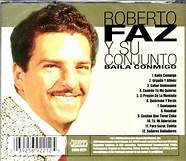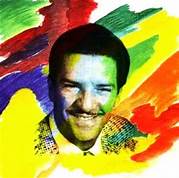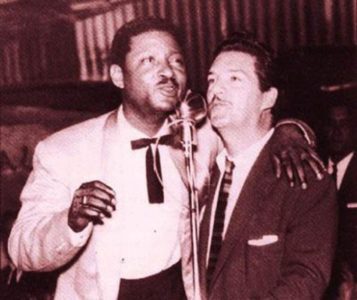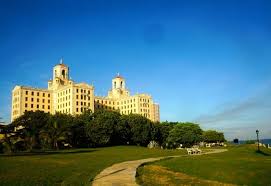ROBERTO FAZ, “LA VOZ DE REGLA”, CANTANTE, SONERO Y BOLERISTA. PHOTOS/VIDEOS.
Roberto Faz esta registrado entre los grandes cantantes soneros y boleristas de Cuba, conocido como “La voz de Regla” Se hacia notar por su siempre naturalidad, carisma y sencillez que lo caracterizaron.
Nacido un 18 de Septiembre de 1914 en el ultramarino pueblo de Regla, en la calle Calixto García No.62 entre Céspedes e Agramonte. Su origen fue muy humilde y desempeñó diversas labores, entre ellas las de conductor de ómnibus y cantinero, a la vez que descargaba, guitarra en mano, por los bares de su pueblo; eran los días gloriosos de la explosión del son en la capital.
Aunque también en la zona de Regla y Guanabacoa había un ambiente folclórico de toques y cantos de bembé de las potencias ñáñigas; unido a las rumbas y congas de comparsas que eran un plato fuerte en esta zona.
CARRERA ARTISTICA
Para ponerse a la moda de la época se integró en 1927 a un septeto infantil llamado Champán Sport, de Carlos Toledo, con el trompetista Félix Chapotín. “Yo le fui enseñando a Robertico –contaba Chapotín- los trucos de la música y el padre me servía un buen almuerzo todos los domingos”. Después el Tropical y el de Ricardo Cabana, que organizaba su propio padre, un famoso cartero del pueblo.
 VIDEOS- Roberto Faz canta “Obsecion”…
VIDEOS- Roberto Faz canta “Obsecion”…
En sus propias palabras contaba Roberto Faz, “Mi padre Pascual era como un representante mío –me dijo el sonero en una ocasión-, él metía cabeza donde quiera para que yo fuera cantante a toda costa y lo logró. Pero te digo que también aprendí a tocar todos los instrumentos de la percusión, esa era una de las distracciones de los jóvenes en aquellos tiempos”.
Ya en 1930 Robertico fue reclamado en diversos septetos como el Ultramar, que también estaba en manos de su padre y ya en 1932 se profesionalizó como cantante en un cabaret llamado Hit. Con ese entrenamiento llegó a cantar en la orquesta Habana, en 1938; en la Cosmopolita, y Los Hermanos Palau, en el aristocrático cabaret Sans Souccí, lo más grande del show en aquellos tiempos.
En 1939 –cuando se creó Tropicana- llegó a ser artista exclusivo de la CMQ de Prado y Monte.
Se presentó en 1941 en el cabaret del Hotel Nacional con la orquesta de Osvaldo Estivil, en la cual también cantó Tito Gómez. Y en 1944 se encontraba nada menos que con Alberto Ruiz en el conjunto Kubavana, que actuaba en el cabaret Zombie Club de Zulueta entre Trocadero y Ánimas, el antiguo Edén Concert. Robertico era un estilo que influyó a casi todos los boleristas en la manera de cantar: fluida, callejera y natural, y que seguirían Orlando Vallejo, Fernando Álvarez y muchos más.
ROBERTO FAZ ENTRA AL CONJUNTO CASINO…
En ese mismo año de 1944 llegó para Roberto Faz la gran oportunidad de su vida: el Conjunto Casino de Roberto Espí, con las voces de Rolito Reyes y Agustín Ribot; un ensemble que haría época en salones y sociedades cubanas. “En el Casino coloqué éxitos con boleros, guarachas y canciones de los filineros como Quiéreme y verás, y Realidad y fantasía, de Portillo de la Luz; A romper el coco, guaracha de Otilio Portal, y Que se corra la bola, guaracha de Alberto Ruiz.
 VIDEOS- Roberto Faz canta “Si los Rumberos…”
VIDEOS- Roberto Faz canta “Si los Rumberos…”
Con el Casino viajó a Estados Unidos y América Latina. En 1948 grabaron para la RCA Víctor; dominaron la radio y la televisión. Se mantuvieron un tiempo en la marquesina del Hotel Saratoga y en Radio Cadena Habana, la emisora musical de Cuba.
Todo eso fue hasta el fin de año de 1955, en que el Casino tuvo cambios en su elenco. Roberto Faz organizó entonces su propio conjunto, con el cual debutó el 4 de febrero de 1956, durante un baile espectacular en el Liceo de Regla, con éxitos como Deuda de Luis Marquetti –apoyados por la Panart Records- que marcó un hito en el conjunto del reglano. En esa etapa viajaron a Cayo Hueso, Tampa y Panamá, mientras que en 1958 realizaron una gira por Centro y Sudamérica con un soberano éxito.
Estuvieron una temporada en 1957 en el cabaret Alí Bar, donde ya el Benny Moré era el Rey. Hay una foto de ambos que queda para la historia. En 1961 grabó el bolero Comprensión de Cristóbal Dobal, un súper éxito; Como vivo en Luyanó, son de René Barrera y Cositas que tiene mi Cuba, son-montuno de Parmenio Salazar.
En la última etapa del conjunto de Roberto Faz se puso de moda en 1966 el dengue con su tiqui tiqui y la llanta de automóvil y el conjunto tomó un nuevo aire: ‘Dengue de la caña’, ‘Dengue del pollo’, y ‘Dengue en Fa’ que arrasó en los carnavales habaneros. También asumieron los ligaditos de boleros con el coro de los trompetistas.
Roberto Faz murió un 26 de abril de 1966, en pleno auge del mozambique. Tres años atrás había desaparecido Benny Moré. La década del 1960 tuvo dos bajas muy duras para la música cubana, dos clásicos que decían adiós a las armas.
El musicólogo Helio Orovio cataloga a Faz: “con su peculiar voz, una de las figuras más completas y aglutinantes que ha conocido nuestra música popular” y artistas como Abelardo Barroso lo definía asi: “amigo intachable y uno de los mejores soneros”. Tito Gómez: “El mejor sonero blanco que dio Cuba”. Miguelito Cuní: “Hombre, amigo, compañero, como sonero, extraordinario. Fue el primer blanco en cantar sones” y su siempre amigo Roberto Espí dijo de el: “Uno de los grandes valores, su nombre esta al lado de Benny Moré y otras grandes figuras”.
DISCOGRAFIA
Quiéreme y verás, de Portillo de la Luz
Realidad y fantasía, de Portillo de la Luz
A romper el coco, guaracha de Otilio Portal
Que se corra la bola, guaracha de Alberto Ruiz
Deuda , de Luis Marquetti
Comprensión , bolero de Cristóbal Dobal
Como vivo en Luyanó , son de René Barrera
Cositas que tiene mi Cuba , son-montuno de Parmenio Salazar.
Dengue de la caña, de su propia autoría
Dengue del pollo, de su propia autoría
Dengue en Fa, de su propia autoría
ROBERTO FAZ, “LA VOZ DE REGLA”, SINGER, SONERO, AND BOLERISTA. PHOTOS/VIDEOS.
Roberto Faz is registered among the great soneros and bolero singers of Cuba, known as “La Voz de Regla” He was noted for his always naturalness, charisma, and simplicity that characterized him.
Born on September 18, 1914 in the ultramarine town of Regla, on Calle Calixto García No.62 between Céspedes and Agramonte. His origins were very humble and he performed various tasks, including bus driver and bartender, while unloading, guitar in hand, through the bars of his town; Those were the glorious days of the son explosion in the capital.
Although in the area of Regla and Guanabacoa there was also a folkloric atmosphere of bembé sounds and songs of the ñáñiga powers; together with the rumbas and congas of comparsas that were the main course in this area.
ARTISTIC CAREER
To catch up with the fashion of the time, in 1927 he joined a children’s septet called Champán Sport, by Carlos Toledo, with the trumpeter Félix Chapotín. “I was teaching Robertico -Chapotin said- the tricks of music and his father served me a good lunch every Sunday”. Then the Tropical and Ricardo Cabana, who organized his own father’s, a famous town postman.
In his own words, Roberto Faz recounted, “My father Pascual was like my representative – the sonero told me on one occasion – he put his head wherever he wanted so that I would be a singer at all costs and he succeeded. But I tell you that I also learned to play all the percussion instruments, that was one of the distractions of young people in those days”.
Already in 1930, Roberto was claimed in various septets such as Ultramar, which was also in the hands of his father, and in 1932 he became a professional singer in a cabaret called Hit. With that training, he came to sing in the Havana orchestra, in 1938; in the Cosmopolita, and Los Hermanos Palau, in the aristocratic cabaret Sans Souccí, the biggest show in those days.
In 1939 -when Tropicana was created- he became the exclusive artist of the CMQ of Prado y Monte.
He appeared in 1941 at the Hotel Nacional cabaret with the Osvaldo Estivil orchestra, in which Tito Gómez also sang. And in 1944 he was with none other than Alberto Ruiz in the Kubavana ensemble, which performed at the Zombie Club cabaret in Zulueta between Trocadero and Ánimas, the old Edén Concert. Roberto was a style that influenced almost all boleristas in the way of singing: fluid, street and natural, and that Orlando Vallejo, Fernando Álvarez, and many more would follow.
ROBERTO FAZ ENTERS THE CASINO COMPLEX…
In that same year, 1944, Roberto Faz had the great opportunity of his life: Roberto Espí’s Conjunto Casino, with the voices of Rolito Reyes and Agustín Ribot; an ensemble that would make an epoch in Cuban salons and societies. “In the Casino, I placed hits with boleros, guarachas, and songs by the filters such as Love me and you will see, Reality and fantasy, by Portillo de la Luz; To break the coconut, guaracha by Otilio Portal, and Let the ball run, guaracha by Albert Ruiz.
With the Casino, he traveled to the United States and Latin America. In 1948 they recorded for RCA Víctor; They dominated radio and television. They stayed for a while on the marquee of the Hotel Saratoga and on Radio Cadena Habana, Cuba’s music station.
All this was until the end of the year 1955 when the Casino had changes in its cast. Roberto Faz then organized his own ensemble, with which he debuted on February 4, 1956, during a spectacular dance at the Liceo de Regla, with hits such as Deuda by Luis Marquetti -supported by Panart Records- which marked a milestone in the ensemble. of the ruler At that stage, they traveled to Key West, Tampa, and Panama, while in 1958 they toured Central and South America with sovereign success.
They spent a season in 1957 at the Alí Bar cabaret, where Benny Moré was already the King. There is a photo of both that remains for history. In 1961 he recorded the bolero Comprehension by Cristóbal Dobal, a super hit; Since I live in Luyanó, they are by René Barrera and Cositas que mi Cuba has, son-montuno by Parmenio Salazar.
In the last stage of Roberto Faz’s ensemble, dengue with its tiqui tiqui and the car tire became fashionable in 1966, and the ensemble took on a new air: ‘Dengue de la caña’, ‘Dengue del poll, and ‘Dengue in Fa’ that swept Havana’s carnivals. They also took on the bolero ligations with the trumpeter choir.
Roberto Faz died on April 26, 1966, in full swing in Mozambique. Three years ago Benny Moré had disappeared. The 1960s had two very hard casualties for Cuban music, two classics that said goodbye to arms.
The musicologist Helio Orovio catalogs Faz: “with his peculiar voice, one of the most complete and agglutinating figures that our popular music has known” and artists such as Abelardo Barroso defined him as follows: “irreproachable friend and one of the best soneros”. Tito Gómez: “The best white sonero that Cuba gave”. Miguelito Cuní: “Man, friend, companion, as a sonero, extraordinary. He was the first white man to sing sones” and his always friend Roberto Espí said of him: “One of the great values, his name is next to Benny Moré and other great figures.”
(READ ROBERTO FAZ DISCOGRAPHY IN THE SPANISH SECTION ABOVE)
Agencies. Wiki. Ecured. Extractos. Excerpts. Internet Photos. YouTube. Arnoldo Varona. www.TheCubanHistory.com
THE CUBAN HISTORY, HOLLYWOOD.










